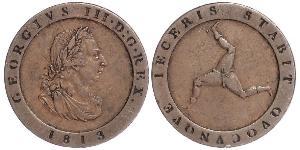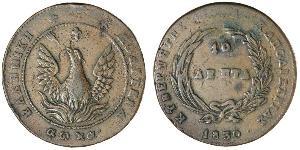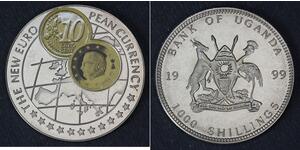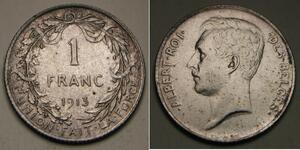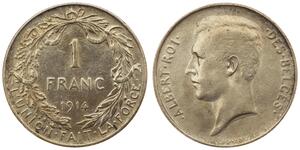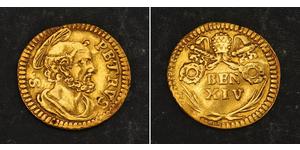(sold for $20.0)
1635, Spanish Netherlands, Brussels (City). Copper "Treasurer" Token / Medal.
Condition: VF+ Mint Year: 1635 Reference: Dugniolle 3898a. Denomination: Medal / Treasurer Token Mint Place: Brusssels (privy mark: cupid´s head) Material: Copper Diameter: 28mm Weight: 5.65gm
Obverse: Sun shining above landscape with a sun-flower in foreground. Legend: DEDIT . EXSPECTATA . TVERI . (privy mark: cupid´s head) .
Reverse: Helmetted, coat-of-arms of the treasurer (who was probably a member of the Serroelofs Lineage, who were responsible for the Anderlecht City Gate) within inner circle. Legend: CALCVLI . AERARII . BRVXELL . 16 (privy mark: cupid´s head) 35.
The Spanish Netherlands (Dutch: Spaanse Nederlanden, Spanish: Países Bajos españoles) in broad sense were the Seventeen Provinces, that came under Habsburg rule after 1482. After 1556 they were under the Spanish Habsburg branch. The northern provinces separated from Habsburg rule during the Eighty Years' War (1568-1648) and became the independent United Provinces after the Oath of Abjuration of 1581. The southern provinces remained under Habsburg rule and formed the Spanish Netherlands in strict sense.
The Seven Noble Houses of Brussels (also called the Seven Lineages or Seven Patrician families of Brussels; French: Sept lignages de Bruxelles, Dutch: Zeven geslachten van Brussel, Latin: Septem nobiles familiae Bruxellarum) were the seven families or clans whose descendants formed the patrician class and urban aristocracy of Brussels.
They formed, since the Middle Ages, a social class with a monopoly, on the civil, military and economic leadership of the urban administration. This institution existed until the end of the Ancien Régime. However, as of the urban revolution of 1421, the representatives of the Guilds also exercised similar offices. Still, the offices of aldermen and captains of the urban militias were always reserved exclusively for members of the Lignages.
The long lived and rarely threatened supremacy of the Seven Houses of Brussels was based on a multitude of common interests they shared with the ducal dynasty of Brabant,[2] as well as the successive Houses of Louvain, Burgundy and Habsburg.
Together with the Guilds of Brussels they formed the Bourgeoisie of the city.
The seven families were first named in a document from 1306 in which John II, Duke of Brabant restores and asserts the existing privileges of the seven families after the citizens of Brussels had violently demanded participation in the city's government. The families named in the document are:
- Sleeus (/sløs/)
- Sweerts (/sweɪrtz/)
- Serhuyghs (/sɛʁɡœz/)
- Steenweeghs (/stenweɡz/)
- Coudenbergh (/kawdən̪bəʁɡ/)
- Serroelofs
- Roodenbeke (/ʁodən̪bɛk/)
All the members of the city council were exclusively recruited and elected from the families who could prove patrilinear or matrilinear descent from the original seven families. However, tradesmen formed the Guilds of Brussels to counter this oligarchical system and in 1421, after violent confrontations, gained some political rights. The rule of the Seven Houses remained predominant until the end of the Ancien Régime, when these special privileges were definitely abolished, along with those of the Guilds. This meant the end of this aristocratic system of government.
Membership and descent of the seven families was carefully recorded in special registers. Applicants needed to provide genealogical evidence that they were descendants of one of the Seven Noble Houses. In addition they needed to be citizens of Brussels, adult, male, catholic, and not earn a living through a trade; instead they were expected to live off the interest of their wealth. Illegitimate children were excluded. Since these criteria were very stringent, few men were accepted to the ranks of this particular patriciate.
Members of the Seven Houses were responsible for defending the gates and city walls of Brussels. Starting in 1383, each House had the task of defending one of the seven gates of the Brussels wall along with a section of that wall. Houses could also use this gate (tower) to imprison members of their own House who had engaged in blameworthy conduct. In 1422, following the bloody events of 1421 that led to a new balance of power between the Brussels patriciate of the Seven Houses and representatives of the trades that will then constitute the Guilds or Nations, this defence of the gates and walls was shared
- The Cologne Gate was defended by the House of Coudenbergh, which was joined in deputy in 1422 by the nation of Saint-Géry.
- The Anderlecht Gate was defended by the House of t’Serroelofs, which was joined in deputy in 1422 by the nation of Saint-Christophe.
- The Laeken Gate was defended by the House of Sleeus, the task was shared from 1422 with the nation of Notre-Dame.
- The Leuven Gate was defended by the House of Steenweghe, seconded in 1422 by the nation of Saint-Jean.
- The Halle Gate was defended by the House of Serhuyghs, seconded in 1422 by the nation of Saint-Laurent.
- The Flanders Gate was defended by the House of Sweerts, seconded in 1422 by the nation of Saint-Gilles.
- The Namur Gate was defended by the House of Rodenbeke, seconded in 1422 by the nation of Saint-Jacques.
In addition to their judicial, administrative and military functions, the Seven Noble Houses of Brussels were also benevolent and concerned about the needs and well-being of the population.
Thus, the urban administration created an administrative relief service for the indigent, called the "Supreme Charity", whose masters-general were chosen only among the members of the Houses at the end of their offices in the urban magistracy.
Between the 12th and 18th centuries, the magistrate of the Noble Houses of the city of Brussels founded numerous official institutions, many old nursing homes, children's institutions, hostels for pilgrims, infirmaries and houses for the poor.
Alongside this, members of the Houses have also had, over the centuries, in their personal capacity, important private charitable activities and created many foundations and hospitals to relieve the misery of the population or members of the Houses that had fallen into poverty. These private foundations continued to exist until the end of the Ancien Régime and were after the French Revolution regrouped in the Hospices Réunis, that still exist today.
Among these charitable foundations founded in a personal capacity by members of Seven Houses, we can mention:
- 1128: Hospice of Saint-Nicholas, mentioned as early as 1128, next to the church of the same name.
- 1263: Hospice of Ter Arken, rue Salazar 17, founded before 1263 by a member of the Clutinc family.
- 1356: Hospice of the Holy Trinity, founded before 1356 by the famous and mystical Heilwige Bloemart called Bloemardine.
- 1388: Foundation of Saint-Élisabeth of Hungary or of Landuyt, founded in 1388 by the bishop Jean t'Serclaes.
- 1522: Hospice of the Holy Cross, rue Haute, founded in 1522 by Charles t'Seraerts.
- 1622: Hospice of t'Serclaes or of Saint-Anne, rue de la Fiancée, founded in 1622 by Anne t'Serclaes.
- 1656-1658: Hospice of the Neuf Chœurs des Anges, rue des Chevaux founded in 1656-1658 by Miss Louise van der Noot.
The annual Ommegang, Brussels' most important lustral procession, celebrated in honor of Our Blessed Lady of the Sablon, the powerful protector of the City of Brussels, is one of the most important moments of the history of the Seven Houses to this day.
It took place on the Sunday before Pentecost, which was also the day of the festival of the city of Brussels.
The magistrates and members of the Seven Noble Houses, dressed in the red scarlet dress - the famous Brussels scarlet stained in the blood of a bull - preceded by the magistrate of the statue of the Virgin Mary, participate as they always have, in this sacred procession.

|
Posted by:
anonymous 2020-12-30 |
1 Franc Belgium Silver
group has 4 coins / 4 prices
⇑
1/2 Scudo Vatican Gold
group has 5 coins / 5 prices
⇑







